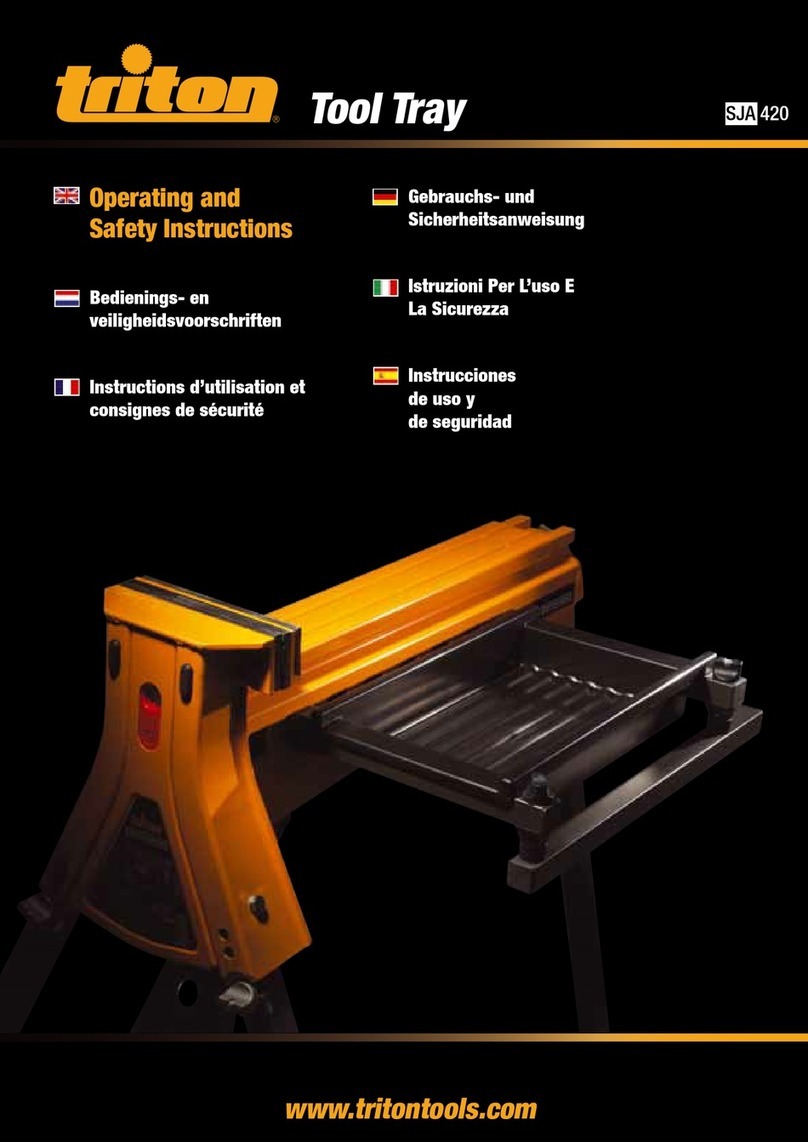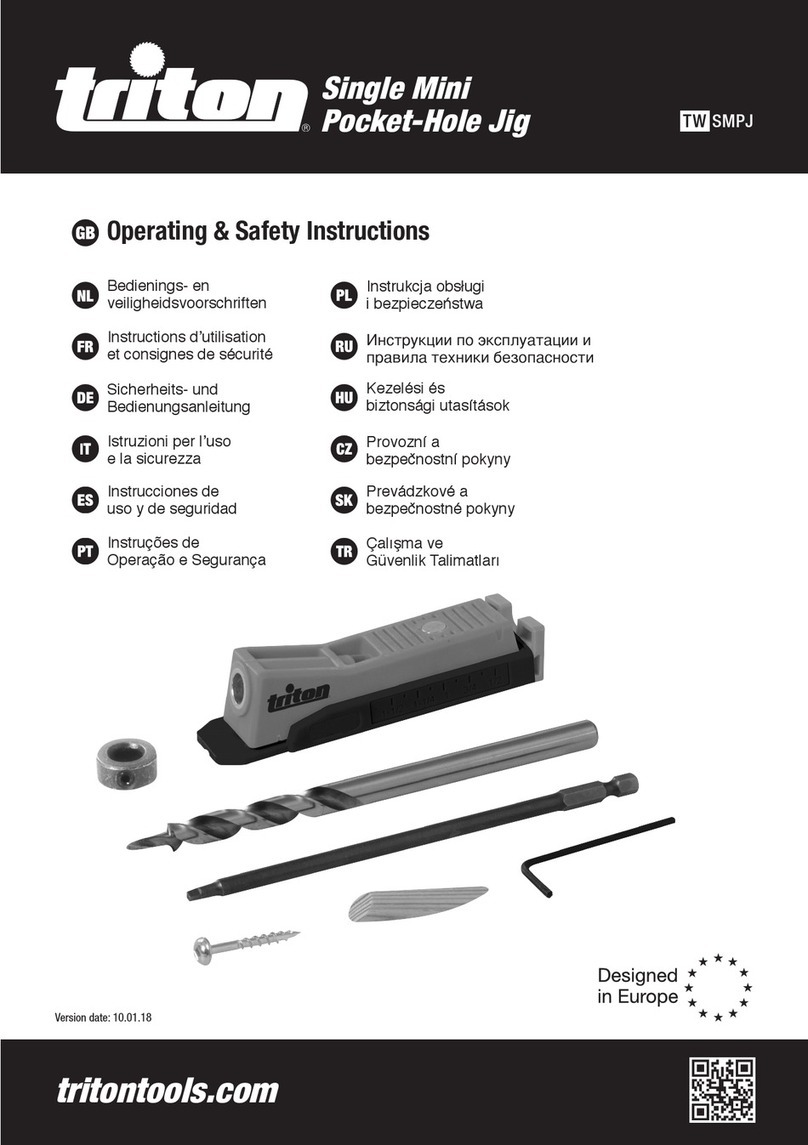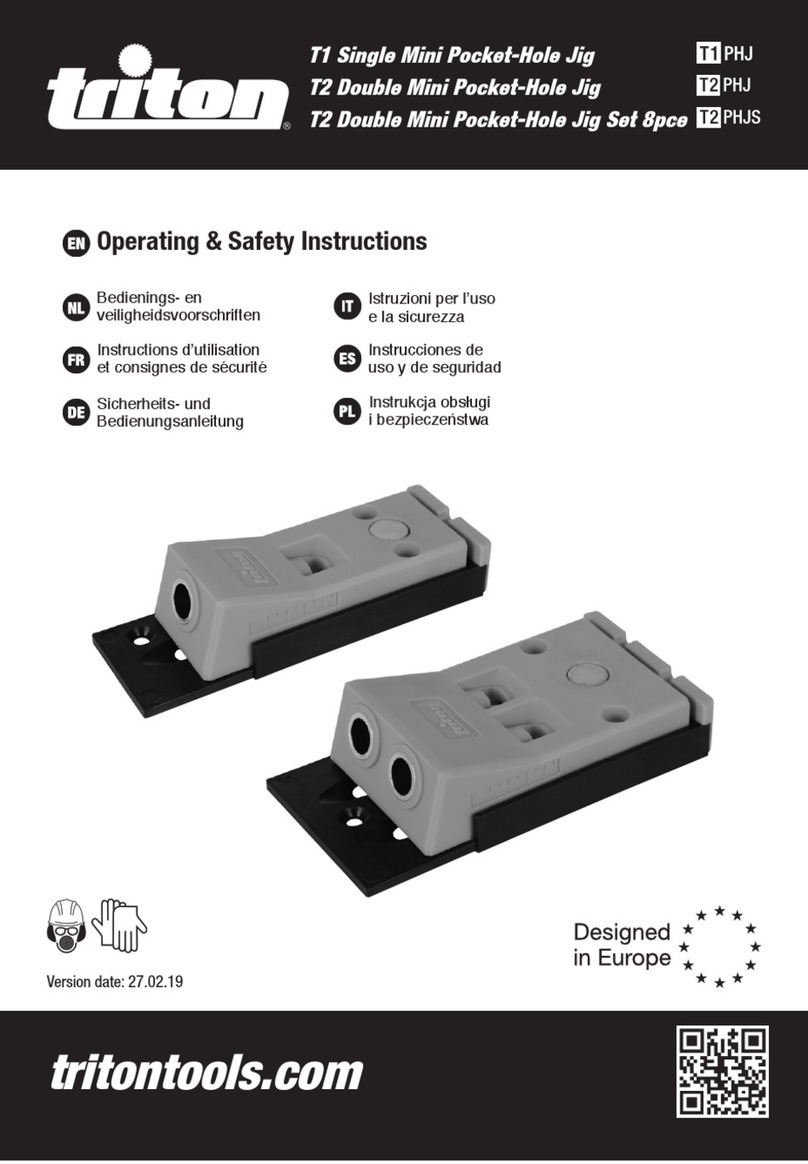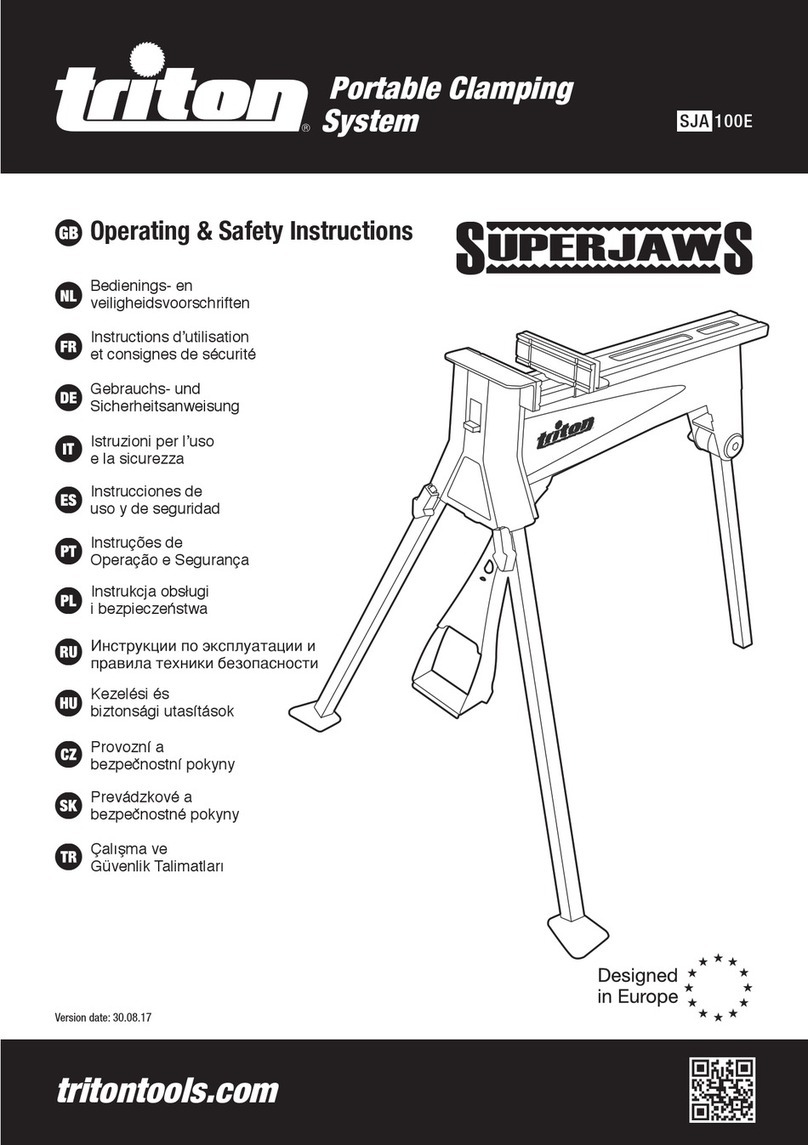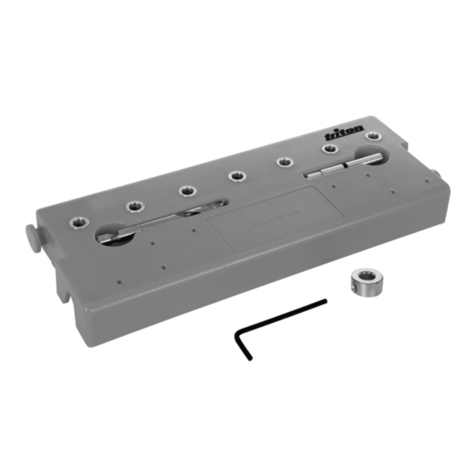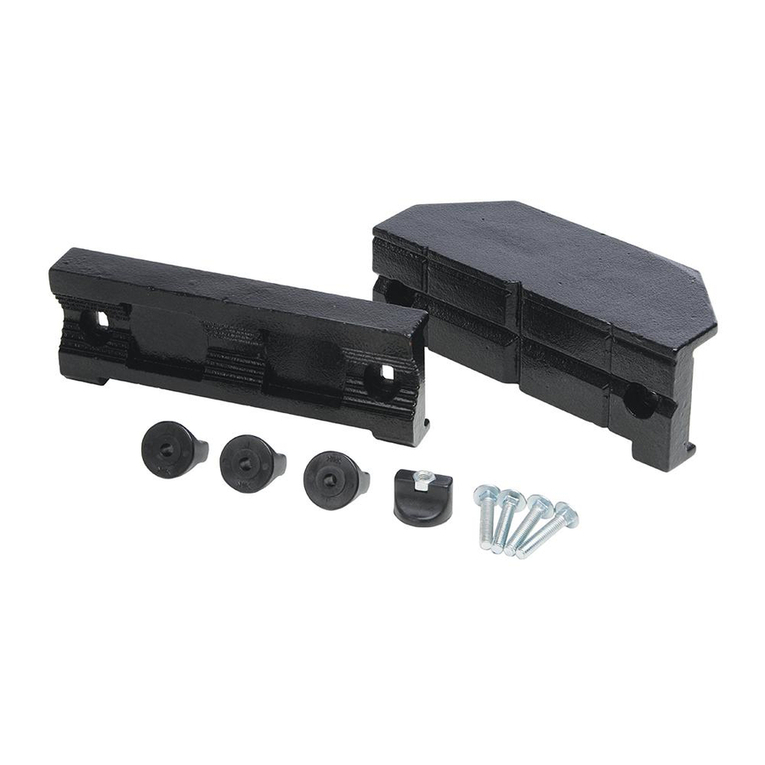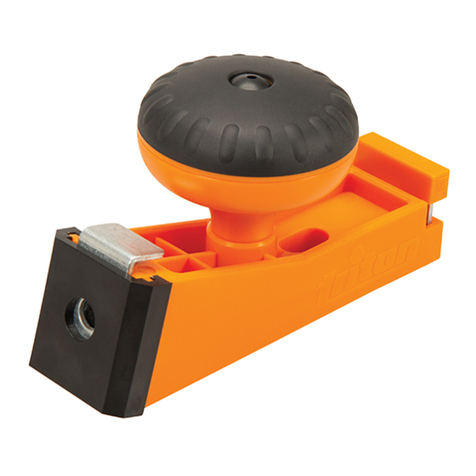
4 5
GB GB
WARNING. Read all safety warnings
and all instructions. Failure to follow the
warnings and instructions may result in
electric shock, fire and/or serious injury.
Save all warnings and instructions for future
reference.
The term 'power tool' in the warnings refers
to your mains-operated (corded) power tool or
battery operated (cordless) power tool.
1. Work area safety
a. Keep work area clean and well lit. Cluttered
and dark areas invite accidents.
b. Do not operate power tools in explosive
atmospheres, such as in the presence of
flammable liquids, gases or dust. Power tools
create sparks which may ignite the dust or
fumes.
c. Keep children and bystanders away while
operating a power tool. Distractions can cause
you to lose control.
2. Electrical safety
a. Power tool plugs must match the outlet. Never
modify the plug in any way. Do not use any
adaptor plugs with earthed (grounded) power
tools. Unmodified plugs and matching outlets
will reduce risk of electric shock.
b. Avoid body contact with earthed or grounded
surfaces such as pipes, radiators, ranges
and refrigerators. There is an increased risk
of electric shock if your body is earthed or
grounded.
c. Do not expose power tools to rain or wet
conditions. Water entering a power tool will
increase the risk of electric shock.
d. Do not abuse the cord. Never use the cord for
carrying, pulling or unplugging the power tool.
Keep the cord away from heat, oil, sharp
edges or moving parts. Damaged or entangled
cords increase the risk of electric shock.
e. When operating a power tool outdoors, use an
extension cord suitable for outdoor use. Use
of a cord suitable for outdoor use reduces the
risk of electric shock.
f. If operating a power tool in a damp location
is unavoidable, use a residual current device
(RCD) protected supply. Use of an RCD
reduces the risk of electric shock.
3. Personal safety
Do not use a power tool while you are tired
or under the influence of drugs, alcohol or
medication. A moment of inattention while
operating power tools may result in serious
personal injury.
a. Use safety equipment. Always wear eye
protection. Safety equipment such as dust-
mask, non-slip safety shoes, hard hat, or
hearing protection used for appropriate
conditions will reduce personal injuries.
b. Avoid accidental starting. Ensure the switch is
in the off position before plugging in. Carrying
power tools with your finger on the switch or
plugging in power tools that have the switch
on invites accidents.
c. Remove any adjusting key or wrench before
turning the power tool on. A wrench or a key
left attached to a rotating part of the power
tool may result in personal injury.
d. Do not overreach. Keep proper footing and
balance at all times. This enables better
control of the power tool in unexpected
situations.
e. Wear suitable clothing and footwear. Do not
wear loose clothing or jewellery. Keep your
hair, clothing and gloves away from moving
parts. Loose clothes, jewellery or long hair can
be caught in moving parts.
f. If devices are provided for the connection of
dust extraction and collection facilities, ensure
these are connected and properly used. Use
of these devices can reduce dust related
hazards.
4. Power tool use and care
a. Do not force the power tool. Use the correct
power tool for your application. The correct
power tool will do the job better and safer at
the rate for which it was designed.
b. Do not use the power tool if the switch
does not turn it on and off. Any power tool
that cannot be controlled with the switch is
dangerous and must be repaired.
c. Disconnect the plug from the power source
before making any adjustments, changing
accessories, or storing power tools. Such
preventive safety measures reduce the risk of
starting the power tool accidentally.
d. Store idle power tools out of the reach of
children and do not allow persons unfamiliar
with the power tool or these instructions
to operate the power tool. Power tools are
dangerous in the hands of untrained users.
e. Always unplug your power tool when leaving
it unattended. Such preventative safety
measures reduce the risk of starting the
power tool accidentally by untrained users.
f. Maintain power tools. Check for misalignment
or binding of moving parts, breakage of parts
and any other condition that may affect the
operation of the power tool. If damaged, have
the power tool repaired before use. Many
accidents are caused by poorly maintained
power tools.
g. Keep cutting tools sharp and clean. Properly
maintained cutting tools with sharp cutting
edges are less likely to bind and are easier to
control.
h. Use the power tool, accessories and tool bits,
in accordance with these instructions and in
the manner intended for the particular type of
power tool, taking into account the working
conditions and the work to be performed. Use
of the power tool for operations different from
those intended could result in a hazardous
situation.
5. Service
a. Have your power tool serviced by a qualified
repair person using only identical replacement
parts. This will ensure that the safety of the
power tool is maintained.
GENERAL SAFETY INSTRUCTIONS
General Safety Instructions General Safety Instructions / Assembly
ASSEMBLY
Skip Figs. (i), (ii) and (iii) if a Height Winder
Kit is not fitted to your saw chassis.
Fitting the Bag
Place the main flap squarely over the saw
chassis, lining up the round hole with the red
locking catch. (Fig.1) Set the saw blade at
full depth and extend the foam slot to about
20mm in front of the blade, using scissors as
shown.
Feed the saw's power cord out through the
motor sleeve, then fit the bag from below,
ensuring the sleeve is on the same side as
the motor. Slide the sleeve along the motor
as far as possible to prevent it falling off in
use (Fig.2). If necessary shorten the sleeve
by rolling it back to avoid excess material
obstructing the cooling air intake.
(If you have fitted a Triton Saw Stabilising
Bracket, you may need to re-locate the rubber
cushion strip and outer band clamp further
along the motor for more secure sleeve
access.)
Wrap the sub-flap over the bearing channel
and attach it to the top section of the bag
using the hook and loop facings. (Fig. 2) Fold
the main flap across the saw and onto the
sub-flap, lining up the hook and loop facings.
(Fig.3)
Push the four foam pieces into the bearing
channels as shown in the inset.
Fit the table, ensuring the saw chassis is
locked in position.
Fit the pouch over the stiffener ring at the
bottom of the dust bag and use the tab to
tighten it. (Fig. 4)
Hook and loop seams in two of the corners
allow access for saw adjustments.
Connecting the Hoses
Screw the Bayonet Connector onto the hose
(note: left-hand thread), and fit it to the dust
port in the overhead guard. (Fig 5)
If you have the optional Triton Dust Collector
(DCA300), push fit the other end of the hose
into one of the dust inlets. If extracting dust
directly into your vacuum cleaner, screw the
Tapered Connector onto the hose and push the
wand of your vacuum cleaner into it. (Fig. 6)
Inserting the Saw Slot Infill Plug
(Series 2000 Workcentres only)
With the saw blade set at full height, push the
plug into the saw slot just in front of the blade.
Ensure the plug is flush with the table. (Fig. 5)
Position the overhead guard support until it
just clears the back of the saw blade. This
dramatically reduces the amount of dust
escaping. Rotate the blade by hand to ensure
the teeth do not hit the guard support.


